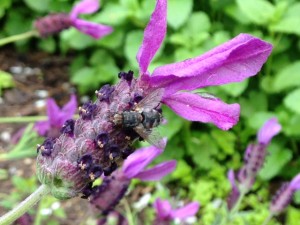As I drive by yards this beautiful spring, I’m amazed by the bright purple colors of spanish lavender. My mother often commented she preferred this lavender over all the others. As a teenager I remember thinking it was “stinky”and that my mom was weird for liking it. I was also unimpressed by its short bloom time. As I got older, I developed an appreciation of the scent, just as I developed a taste for red wine. 😉
Upon closer inspection of spanish lavender flowers, one might think they look like rabbits. At least most garden books describe them that way. Personally, I think they look like mini tubular brushes topped with flags. The interesting thing about the flowers is that the bottle and the flags can be different colors.
Spanish lavender’s botanical name is Lavandula stoechas, so if you are trying to purchase the plant when it is out of bloom, make sure and have this name with you. All lavender will have the first name (genus) Lavandula, (abbreviated L.) but the species’ names may be different. Often there is a third name, which is the variety. For example, there are a few varieties of L. stoechas such as L. stoechas ‘Hazel’ which has dark purple “tubes” and bright purple “flags.” Or L. stoechas ‘Otto Quast’ which has maroon “tubes” and red-purple “flags.”
If you decide to plant this lavender in your garden, give it a sunny spot with at least 6-8 hours of sun. Once established, it will need little to no water and minimal care to keep it looking healthy. After the first bloom in spring, shear the plant back (mostly trim off the flowers and cut a little foliage) and you may get a second round of blooms in early summer. The flowers attract birds,bees, moths, butterflies and people.
The bloom time is short, so don’t make spanish lavender a feature plant in your landscape, but rather an accent plant that can be counted on in early spring. This photo shows how well spanish lavender mixes well with other colorful blooming plants, such as pink salvia (variety unknown, I will go back and check one of these days). Plant with other drought tolerant plants such as evening primrose (oenothera), penstemon, santolina, gaura or wild buckwheat for a low-water use landscape.
Comments
comments
